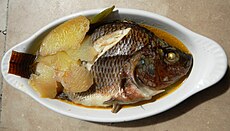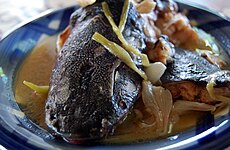Pinangat na isda
  Top: Pinangat na tilapia with green mangoes Bottom: Pinangat na hito (catfish) | |
| Type | Stew |
|---|---|
| Place of origin | Philippines |
| Region or state | Southern Luzon |
| Created by | Filipino cuisine |
| Main ingredients | Fish, tomatoes, salt, souring agent (calamansi, bilimbi, tamarind, santol, etc.) |
| Similar dishes | Sinigang, paksiw |
Pinangat na isda, also called pangat na isda, is a Filipino dish from Southern Luzon consisting of fish and tomatoes stewed in a broth soured with fruits like calamansi, bilimbi, tamarind, or santol. It can also be used to cook shrimp. It is similar to sinigang, but it is not as tart.[1][2][3][4][5][6]
Pinangat na isda may also sometimes be referred to as paksiw, a related but different dish which primarily uses vinegar to sour the broth.[7][8] Pinangat na isda is also commonly confused with laing (also called pinangat na laing or pinangat na gabi), a Bicolano dish also known simply as pinangat. But they are different dishes.[9][4]
See also[]
- Ginataang isda
- Linarang
- Sinampalukan
- Tinola
- Cuisine of the Philippines
References[]
- ^ "Pinangat na Isda Fish Poached in Kamias and Tomatoes". Filipino-food-recipes.com. Retrieved 10 January 2019.
- ^ Belen, Jun (2011-06-15). "How to Make Fish Pinangat (Fish Soured in Calamansi and Tomatoes)". Junblog. Retrieved 10 January 2019.
- ^ "Pinangat na Hiwas (Pangat na Isda)". The Peach Kitchen. 2016-01-29. Retrieved 10 January 2019.
- ^ a b "Pinangat na Isda Recipe". Panlasang Pinoy. 2011-05-22. Retrieved 10 January 2019.
- ^ "How to cook Pinangat na Tilapia – Fish Stew in Tomatoes". Asian in America. 2018-02-21. Retrieved 10 January 2019.
- ^ "Pinangat na Bangus sa Sampalok / Milkfish Soured in Tamarind Broth a la Marketman". Market Manila. Retrieved 10 January 2019.
- ^ Riwada, Gae (2017-01-02). "Pinangat na Bangus (Mangan)". Gae Riwada. Retrieved 10 January 2019.
- ^ "Pangat na Isda (pinangat or Paksiw)". Filipino Dishes and Recipes. Retrieved 10 January 2019.
- ^ "Pinangat na Isda (Fish Soured in Calamansi and Tomato)". Pinoy Kusinero. Retrieved 10 January 2019.
Categories:
- Philippine stews
- Fish dishes
- Philippine seafood dishes
- Filipino cuisine stubs
